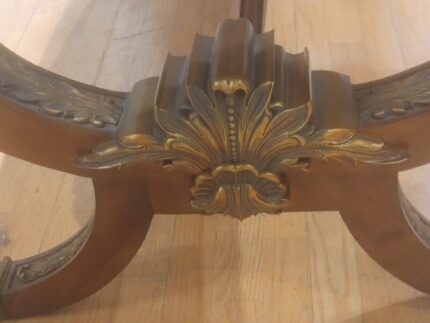The central rectangular mirror plate is shaped with a bevelled edge. It features a swan neck pediment flanked by urn finials and is beautifully inlaid with floral marquetry embellished with penwork.
Raised on square columns with boxwood and ebony line inlay throughout, the whole supported on swept supports with brass lion’s paw castors.
Condition:
In excellent original condition. Castors and knobs original and complete, the mirror plate original but slightly spotted
Dimensions in cm:
Height 184 x width 74 x depth 66
Dimensions in inches:
Height 72.4 x width 29.1 x depth 26.0
Cheval mirror, also called horse dressing glass or psyche, a tall dressing mirror, suspended between two pillars, usually joined by horizontal bars immediately above and below the mirror and resting on two pairs of long feet.
The cheval glass was first made toward the end of the 18th century. The mirror could be tilted at any angle by means of the swivel screws supporting it, and its height could be adjusted by means of lead counterweights and a horse, or pulley, from which the name was taken.
Thomas Sheraton, in The Cabinet Dictionary (1803), included a design with a nest of drawers at one side and another with a writing surface. When wardrobes were fitted with mirrored doors, the cheval glass became unnecessary in bedrooms.
Satinwood
is a hard and durable wood with a satin like sheen, much used in cabinetmaking, especially in marquetry. It comes from two tropical trees of the family Rutaceae (rue family). East Indian or Ceylon satinwood is the yellowish or dark-brown heartwood of Chloroxylon swietenia.
The lustrous, fine-grained, usually figured wood is used for furniture, cabinetwork, veneers, and backs of brushes. West Indian satinwood, sometimes called yellow wood, is considered superior. It is the golden yellow, lustrous, even-grained wood found in the Florida Keys and the West Indies.
It has long been valued for furniture. It is also used for musical instruments, veneers, and other purposes. Satinwood is classified in the division Magnoliophyta, class Magnoliopsida, order Sapindales, family Rutaceae.
-
Dimensions:Height: 72.45 in (184 cm)Width: 29.14 in (74 cm)Depth: 25.99 in (66 cm)
-
Style:Edwardian(Of the Period)
-
Materials and Techniques:MirrorSatinwoodMarquetry
-
Place of Origin:England
-
Period:1900-1909
-
Date of Manufacture:circa 1900
-
Condition:Good
-
Seller Location:London, GB
-
Reference Number:Seller: 09968aSeller: LU950617558331

















































Reviews
There are no reviews yet.